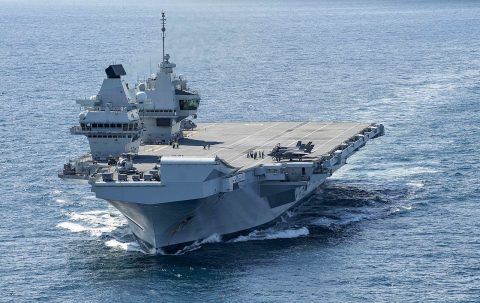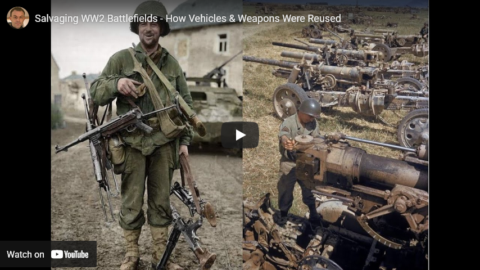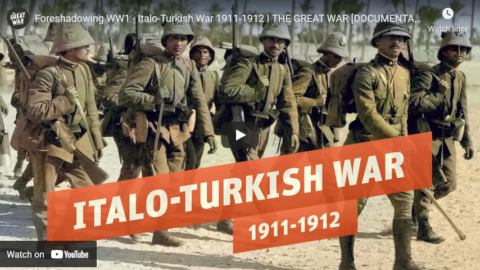Mark Felton Productions
Published 25 Nov 2021After the wounded and dead had been removed from a battlefield, what happened to all the military vehicles and weapons left lying around? Find out here.
Dr. Mark Felton is a well-known British historian, the author of 22 non-fiction books, including bestsellers Zero Night and Castle of the Eagles, both currently being developed into movies in Hollywood. In addition to writing, Mark also appears regularly in television documentaries around the world, including on The History Channel, Netflix, National Geographic, Quest, American Heroes Channel and RMC Decouverte. His books have formed the background to several TV and radio documentaries. More information about Mark can be found at: https://en.wikipedia.org/wiki/Mark_Fe…
Help support my channel:
https://www.paypal.me/markfeltonprodu…
https://www.patreon.com/markfeltonpro…Disclaimer: All opinions and comments expressed in the ‘Comments’ section do not reflect the opinions of Mark Felton Productions. All opinions and comments should contribute to the dialogue. Mark Felton Productions does not condone written attacks, insults, racism, sexism, extremism, violence or otherwise questionable comments or material in the ‘Comments’ section, and reserves the right to delete any comment violating this rule or to block any poster from the channel.
Credits: US National Archives; Library of Congress
Thumbnail colorisation (left image) by Paul Reynolds
March 10, 2022
Salvaging WW2 Battlefields – How Vehicles & Weapons Were Reused
February 24, 2022
Got Wood? – The de Havilland Mosquito
World War Two
Published 23 Feb 2022What if there was a plane that the enemy could neither catch nor reach? One that fully relied on speed instead of defensive armaments? The de Havilland DH.98 Mosquito was the first multi-role aircraft developed during World War Two. Made mostly out of wood, the “Wooden Wonder” could be easily converted into different roles — a fighter, a fighter-bomber, a bomber, and a reconnaissance aircraft.
(more…)
February 4, 2022
Proposed Advanced Variants of the Avro Canada CF-100 Canuck
Polyus Studios
Published 20 Nov 2018Don’t forget to like the video and subscribe to my channel!
Support me on Patreon – https://www.patreon.com/polyusstudiosThis video covers some of the advanced variants that were proposed for to enhance the capabilities of the CF-100 Canuck. It covers both weapon systems and a few airframe redesigns.
0:00 Introduction
0:55 Velvet Glove and Sparrow 2 missiles
1:36 Falcon and Sidewinder missiles
2:22 Eagle missile
2:53 Genie nuclear rocket
3:18 Engine testing
3:50 Canuck Mk10
4:40 VTOL Canuck
6:03 ConclusionMusic:
Denmark – Portland Cello Project#CF100 #CanadianAerospace #PolyusStudios
December 30, 2021
The Army’s Labor Union: Winchester 94s for the Loyal Legion of Loggers & Lumbermen
Forgotten Weapons
Published 30 Aug 2021http://www.patreon.com/ForgottenWeapons
https://www.floatplane.com/channel/Fo…
Cool Forgotten Weapons merch! http://shop.forgottenweapons.com
Today we have a rifle from a really neat forgotten corner of American military history. During World War One, the Pacific Northwest was the source of prime lumber, in particular Sitka Spruce that was ideal for aircraft production. The US military wanted that spruce for its own aircraft, and there was also massive demand from France and the UK for their production as well. As part of the American war effort, the Signal Corps (which oversaw military aviation) set about increasing spruce production severalfold.
The Corps sent a Colonel to investigate what would be necessary to do this, and he found that logging work was being significantly disrupted by labor union organizing, ranging from strikes to active sabotage. In response, the Army essentially created its own labor union, the Loyal Legion of Loggers and Lumbermen which both provided some of the labor reforms sought by groups like the IWW and also succeeded in massively increasing timber output for the war. The LLLL is a mostly-forgotten organization, and most of the documentation on it is from very left-wing organizations that paint it as a government attempt to quash labor rights. The reality appears to be far more nuanced, with several very legitimate reforms instituted in good faith. Unfortunately, the best reference on this period is completely out of print, Soldiers and Spruce: Origins of the Loyal Legions of Loggers & Lumberman by Harold Hyman (https://amzn.to/3lErrRC).
At any rate, part of the effort included the creation of the Spruce Production Division — 25,000 soldiers (mostly with backgrounds in logging and lumber) to Vancouver. They were seconded to private logging companies with Army-subsidized wages, but retained a military structure and officer corps. The Signal Corps purchased about 1,800 Winchester Model 1894 rifles in .30-30 caliber to arm a segment of the Division for security and military police type duties. Winchester 94s were in production and readily accessible, and the Division’s mission did not justify giving them Enfield or Springfield rifles needed by troops in Europe. These Winchesters were marked with a “US” property stamp and flaming bomb, and had serial numbers between 835,000 and 853,000 (specific numbers are not known because Winchester’s records form this period were destroyed). When the war ended, the guns (along with the Division’s other equipment) were sold as surplus, and they are found to this day in the Northwest. Many are in poor condition from decades of hard use, and they can be difficult to identify (and are also faked …) but they are a really neat artifact of a long-forgotten part of World War One history.
Contact:
Forgotten Weapons
6281 N. Oracle 36270
Tucson, AZ 85740
December 29, 2021
War in Numbers 1942 – WW2 Special
World War Two
Published 28 Dec 2021Quantity had a quality of its own. 1942 was the year in which the dimensions of the Second World War became truly apparent. The US and its unmatched economic power began to outproduce any other warring nation, manufacturing a fleet of ships and aircraft in record time. In the east Soviet industry began recovering itself, producing tens of thousands of tanks despite tremendous losses. All the while the German logistic system got overwhelmed by the vastness of the occupied territory.
(more…)
December 20, 2021
Foreshadowing WW1 – Italo-Turkish War 1911-1912 I THE GREAT WAR
The Great War
Published 17 Dec 2021Sign up for Audible and get 60% off your first three months: https://audible.com/greatwar or text
greatwarto 500-500The Italo-Turkish War 1911 was one of the last classic imperial wars over colonial processions between two great powers. But it was in many ways also a first glimpse into what would come during the First World War: trenches, artillery, combat aircraft, motorboat attacks. This war in Ottoman Libya was fought between the Italian Army and Ottoman-led local Senussi forces.
» SUPPORT THE CHANNEL
Patreon: https://www.patreon.com/thegreatwar» THANKS TO OUR CO-PRODUCERS
John Ozment, James Darcangelo, Jacob Carter Landt, Thomas Brendan, Kurt Gillies, Scott Deederly, John Belland, Adam Smith, Taylor Allen, Rustem Sharipov, Christoph Wolf, Simen Røste, Marcus Bondura, Ramon Rijkhoek, Theodore Patrick Shannon, Philip Schoffman, Avi Woolf,» SOURCES
Askew, William C., Europe and Italy’s Acquisition of Libya, 1911-1912, (Durham, NC: Duke University Press, 1942)Caccamo, Francesco, “Italy, Libya and the Balkans” in Geppert, Dominik; Mulligan, William & Rose, Andreas (eds.), The Wars before the Great War: Conflict and International Politics Before the Outbreak of the First World War, (Cambridge: Cambridge University Press, 2016)
Childs, Timothy W, Italo-Turkish Diplomacy and the War Over Libya, 1911–1912, (Leiden: Brill, 1990)
Griffin, Ernest H., Adventures in Tripoli: A Doctor in the Desert (London: Philip Allen & Co., 1924)
Hindmarsh. Albert E. & Wilson, George Grafton, “War Declared and the Use of Force”, Proceedings of the American Society of International Law at Its Annual Meeting (1921-1969) Vol. 32 (1938)
McCollum Jonathan, “Reimagining Mediterranean Spaces: Libya and the Italo-Turkish War, 1911-1912”, in Mediterraneo cosmopolita, 23 (3) 2015.
McMeekin, Sean, The Ottoman Endgame (Penguin, 2013).
Paris, Michael, “The First Air Wars – North Africa and the Balkans, 1911-13”, Journal of Contemporary History, Vol. 26, No. 1 (1991)
Stephenson, Charles, A Box of Sand: the Italo-Ottoman War 1911-1912: the First Land, Sea and Air War, (Ticehurst: Tattered Flag Press, 2014)
Tittoni, Renato, The Italo-Turkish War (1911-12). Translated and Compiled from the Reports of the Italian General Staff, (Kansas City, MO: Frank Hudson Publishing Company, 1914)
Uyar, Mesut, The Ottoman Army and the First World War, (Abingdon: Routledge, 2021)
Vandervort, Bruce, Wars of Imperial Conquest in Africa 1830-1914, (Bloomington, IN: Indiana University Press, 1998)
Wilcox, Vanda, Italy in the Era of the Great War, (Leiden: Brill, 2018)
Wilcox, Vanda, “The Italian Soldiers’ experience in Libya, 1911-12” in Geppert, Dominik; Mulligan, William & Rose, Andreas (eds.), The Wars before the Great War: Conflict and International Politics Before the Outbreak of the First World War, (Cambridge: Cambridge University Press, 2016)
»CREDITS
Presented by: Jesse Alexander
Written by: Mark Newton, Jesse Alexander
Director: Toni Steller & Florian Wittig
Director of Photography: Toni Steller
Sound: Toni Steller
Editing: Jose Gamez
Motion Design: Philipp Appelt
Mixing, Mastering & Sound Design: http://above-zero.com
Research by: Mark Newton
Fact checking: Florian WittigChannel Design: Yves Thimian
Contains licensed material by getty images
All rights reserved – Real Time History GmbH 2021
December 19, 2021
Canada’s almost functional flying saucer; the story of the Avro Canada VZ-9 Avrocar
Polyus Studios
Published 14 Jul 2018Support me on Patreon – https://www.patreon.com/polyusstudios
The Avro Canada VZ-9AV Avrocar: Canada’s first attempt at vertical take off and landing aircraft. Although the concept ultimately turned out to be a dead-end, the engineers and designers at Avro experimented with bold new ideas. Their concepts would push the limits of the imagination and reflected the extreme technological optimism of its time.
Music:
Denmark – Portland Cello ProjectResearch Sources:
“Declassified: America’s Secret Flying Saucer” – https://www.popularmechanics.com/mili…
Avro Canada VZ-9 Avrocar – https://www.aviationsmilitaires.net/v…
Avrocar: Canada’s Flying Saucer: The Story of Avro Canada’s Secret Projects by Bill Zuk (2001)
How to Build a FLYING SAUCER – https://declassification.blogs.archiv…
LaesieWorks – AVROCAR VZ-9AV – http://www.laesieworks.com/ifo/lib/AV…
The Living Moon – Project Silverbug – The Avrocar – http://www.thelivingmoon.com/49ufo_fi…Footage Sources:
Avrocar I Progress Report 01/02/1958 – 05/1959 – US National Archives (~1959)
Disc Flight Development, Avrocar I Progress Report, 05/02/1959 – 04/12/1960 – US National Archives (~1960)
Avrocar Continuation Test Program and Terrain Test Program, 06/01/1960 – 06/14/1961 – US National Archives (~1959)
Tiltwing Versatility – San Diego Air and Space Museum (~1971)Aircraft mentioned:
Project Y
Project Y-2
Project PV 704
Project 1794
Project Silverbug
Weapon System 606A
VZ-9AV Avrocar
CL-84 Dynavert#Avrocar #CanadianAerospace #Polyus
December 16, 2021
Supersonic Firsts
The History Guy: History Deserves to Be Remembered
Published 20 Aug 2021On August 20, 1955, United States Air Force Colonel Horace A Hanes set the world’s first supersonic world speed record in a North American Aviation F-100C Super Sabre. Although we are well into the supersonic age, aircraft that can exceed the speed of sound are still rare machines, and marvels of engineering and pilot prowess. The early aviation pioneers who tested the terrifying sound barrier have helped scientists better understand the dynamics of superfast speeds.
This is original content based on research by The History Guy. Images in the Public Domain are carefully selected and provide illustration. As very few images of the actual event are available in the Public Domain, images of similar objects and events are used for illustration.
You can purchase the bow tie worn in this episode at The Tie Bar:
https://www.thetiebar.com/?utm_campai…All events are portrayed in historical context and for educational purposes. No images or content are primarily intended to shock and disgust. Those who do not learn from history are doomed to repeat it. Non censuram.
Find The History Guy at:
Patreon: https://www.patreon.com/TheHistoryGuy
Please send suggestions for future episodes: Suggestions@TheHistoryGuy.netThe History Guy: History Deserves to Be Remembered is the place to find short snippets of forgotten history from five to fifteen minutes long. If you like history too, this is the channel for you.
Awesome The History Guy merchandise is available at:
teespring.com/stores/the-history-guyScript by THG
#history #thehistoryguy #airforce
November 28, 2021
A bit of perspective on the loss of the British F-35 from HMS Queen Elizabeth
At the Thin Pinstriped Line, Sir Humphrey offers a bit of historical perspective on peacetime aircraft losses:

Royal Navy aircraft carrier HMS Queen Elizabeth (R08) underway in the Atlantic on 17 October 2019, participating in exercise “WESTLANT 19”.
Photo by Mass Communication Specialist 3rd Class Nathan T. Beard, US Navy, via Wikimedia Commons.
If you look at historical data, then it shows that for decades, flying fast jets was an exceptionally dangerous occupation. In 1956 the RAF lost six Hawker Hunter aircraft in the space of just 45 minutes. These were just six of no less than 380 British military aircraft and helicopters lost in 1956, which averages out at more than one aircraft lost every day of the year – and this was not an unusual year.
Fast jet flying is and always has been an extremely dangerous business, which requires the highest levels of safety, standards and training to carry out. Over the intervening decades there has been a general decline in losses due to changes in equipment, reliability of machinery and different ways of operating, particularly with new technology, but there is still an element of risk. In particular the Martin Baker ejection seat is worth mentioning – this incident reminds us of the many lives this British company is responsible for saving over many decades.
Carrier aviation in particular remains an extremely dangerous occupation, even if crash rates have dropped. It is important to understand that the combination of fast jets, large warships and complex operating conditions can, and do, sometimes go wrong. We must not assume that aircraft will not crash anymore.
The Wikipedia page covering military aviation accidents for the period 2010-2019 is a good read to understand how risky military aviation is, and how many aircraft have been lost globally during this period.
That said, the current crop of modern British fast jets like the F35 and Typhoon have a phenomenal safety record, being operated in hugely demanding conditions around the globe for many years, and with only a handful lost. It is very telling that the loss of an aircraft is something that has gone from the utterly routine and barely newsworthy, to something that can dominate the media cycle for several days and generate huge national media coverage.
The theme on social media has been peculiar — there have been many posters talking about how embarrassing it is for the UK, or that its somehow a national disgrace that the aircraft crashed, particularly with the US embarked as well. This is utter nonsense – there is no embarrassment in a pilot taking a decision to eject in order to save his life. That is absolutely the right thing to do, and anyone who thinks otherwise has clearly never been faced with the decision on whether to eject or not.
There has been some coverage suggesting that the F35 programme is troubled in some way and that this is a setback for it. Again, this is nonsense – the aircraft first flew 15 years ago, and well over 700 have now been produced flying over 400,000 flying hours. In this time, a total of 5 aircraft (3 American, 1 Japanese and 1 British) have been lost – this is an under 1% loss rate, or one aircraft lost for every 80,000 hours in the sky.
By way of contrast, the Sea Vixen, a British jet used for carrier operations was in service from 1959-1971. Of the 145 aircraft built and operated, no less than 55 were lost in accidents in this period – a loss rate of around 38% of the whole force in just 12 years.
November 12, 2021
Britain’s Highly Unusual Crescent-Wing Victor Bomber
Dark Skies
Published 2 Nov 2021The V force was a legendary team of bombers built to serve during the post-war crisis. However, they would not carry ordinary bombs, but nuclear weapons.
As World War II ended, the division between the West and the East became a significant threat to world peace, and shortly before the Cold War began, Britain started working on a modern jet bomber force that could rival any other on the planet.
The Handley Page Victor featured a one-of-kind wing, making it the largest aircraft to break the sound barrier up to that point.
As the British mastered the atomic bomb by the mid-1950s with the exceptional V force and the Victor to deliver it, Britain’s stature among the world’s superpowers significantly solidified.
—
Join Dark Skies as we explore the world of aviation with cinematic short documentaries featuring the biggest and fastest airplanes ever built, top-secret military projects, and classified missions with hidden untold true stories. Including US, German, and Soviet warplanes, along with aircraft developments that took place during World War I, World War 2, the Korean War, the Vietnam War, the Cold War, the Gulf War, and special operations missions in between.
As images and footage of actual events are not always available, Dark Skies sometimes utilizes similar historical images and footage for dramatic effect and soundtracks for emotional impact. We do our best to keep it as visually accurate as possible.
All content on Dark Skies is researched, produced, and presented in historical context for educational purposes. We are history enthusiasts and are not always experts in some areas, so please don’t hesitate to reach out to us with corrections, additional information, or new ideas.
October 14, 2021
Canada’s carrier-borne fighters onboard HMCS Bonaventure; the story of the McDonnell F2H-3 Banshee
Polyus Studios
Published 2 Apr 2021Don’t forget to like the video and subscribe to my channel!
Support me on Patreon – https://www.patreon.com/polyusstudiosUp until the late 1960s the Canadian Navy operated a modern aircraft carrier. It had an angled flight deck, steam catapults, and fighter jets. The jets were comparable to land-based aircraft like the CF-100 but could pack a vicious air-to-air punch with their Sidewinder missiles. They saw a brief service aboard HMCS Bonaventure before being retired without replacement. It was the McDonnell F2H Banshee, Canada’s premiere sea-based jet fighter.
0:00 Introduction
0:29 Canadian Navy aircraft carriers 1945 to 1957
2:13 New Fighter Selection
3:34 Specifications
5:07 Comparison to the CF-100
5:50 Operational Service
8:23 Accidents and RetirementMusic:
Denmark – Portland Cello ProjectResearch Sources:
CASM-Aircraft Histories – HMCS Bonaventure CVL-22 by Robert T. Murray
McDonnell Banshee – Royal Canadian Air Force – http://www.rcaf-arc.forces.gc.ca/en/a…
Magnificent Moments by Vintage Wings of Canada – http://www.vintagewings.ca/VintageNew…
McDonnell Banshee – Shearwater Aviation Museum – http://www.shearwateraviationmuseum.n…
HMCS Bonaventure: Canada’s Last Aircraft Carrier by Kevin Patterson – http://www.sevenyearproject.com/canad…Footage Sources:
HMCS Magnificent (CVL 21) – Majestic Class Light Aircraft Carrier – Camildoc – https://youtu.be/_Zvnz06-MRc
HMCS Bonaventure (CVL 22) – Majestic Class Aircraft Carrier – Camildoc – https://youtu.be/QmFD5bijrok#Banshee #CanadianAerospace #PolyusStudios
October 12, 2021
The Southwest canary in the coal mine?
Jim Treacher wonders, based reactions from the self-imagined elites, if they consider airline pilots to be slaves now:
I’m one of the pesky minority of Americans who are both pro-vaccine and against vaccine mandates. The evidence overwhelmingly proves that these vaccines are effective against the coronavirus, and I will continue to encourage everyone to get vaccinated. And, also, in addition to that, vaccine mandates are not only un-American but counterproductive. In addition to all the other dishonest, lame-brained, self-negating messaging we’ve heard during this pandemic, telling Americans what to do just doesn’t work. That’s not how we’re built.
And just on principle, vaccination is your decision as an individual. That’s how it’s supposed to work in this country. This is still a republic, if you can keep it.
Which is why it’s interesting that now this is happening:
Southwest is the only airline cancelling so many flights. Is that because the employees, including the pilots who are needed to fly the planes, are refusing to comply with the company’s new vaccine mandate?
The airline is saying otherwise:
“Disruptive weather”? Wouldn’t that affect all the airlines, not just one?
In any case, the smart fellers seem to think it’s about the vaccine. And they ain’t happy:
Oh, is that how it works? Those pilots are no longer individual human beings, with individual thoughts and opinions? They must subsume themselves into the corporation? The government throws money at everything in sight, and therefore all that stuff is owned by the government? All those people are owned by the government?
And these clowns call us fascists?
Airline pilots aren’t slaves. If they don’t want to work because of an employer’s mandate, that’s between them and the employer. If they get fired, that’s their problem. But nobody owns them, let alone entitled @$$holes like Andrew Ross Sorkin.
Of course, you can always trust The Babylon Bee (America’s Most Trusted News Source™) to get to the heart of the matter:
August 6, 2021
Avro Canada CF-100 Canuck: Canada’s only domestically produced all-weather interceptor
Polyus Studios
Published 3 Oct 2017Support me on Patreon – https://www.patreon.com/polyusstudios
**I realize a few of you are having trouble with the way I talk and how I’ve done the sound mixing. Please note that this was my first video and I tried to get everything right as I learned to do it. That said, I obviously made some mistakes. I am just one guy making these things and I’m learning as I go. Feel free to check out my more recent videos where I have tried to correct the sound issues.**
The CF-100 is Canada’s only domestically designed jet fighter to reach service and to be built directly to RCAF specifications. In its day it was a competitive all-weather interceptor. The Canuck protected Canadian airspace from the threat of nuclear armed Soviet bombers for over a decade. This is the story of its development and deployment.
Aircraft mentioned:
Vampire F.3
CL-13 Sabre
CF-100 Canuck
CF-101 Voodoo
CF-105 ArrowResearch sources:
http://www.cmp-cpm.forces.gc.ca/dhh-d…
https://www.bombercommandmuseum.ca/aircraft/cf-100/
http://www.canadianflight.org/content/avro-canada-cf-100-canuck
http://www.avroland.ca/al-cf100.html
http://www.aviastar.org/air/canada/canada_canuck.php
http://www.rwrwalker.ca/caf_canucks.html
http://image-bank.techno-science.ca/d…
NORAD and the Soviet Nuclear Threat: Canada’s Secret Electronic Air War By Gordon A.A. Wilson0:00 Introduction
1:08 Initial Development
2:38 CF-100 Mk 1 and Mk 2
4:26 CF-100 Mk 3
6:51 CF-103 and Transonic Speeds
7:36 CF-100 Mk 4
11:33 CF-100 Mk 5
13:14 Velvet Glove and Future Proposals
14:28 Operational History
20:02 Conclusion#CF100 #CanadianAerospace #PolyusStudios
June 30, 2021
Questions the dying media daren’t ask Biden
Kurt Schlichter offers a few questions that an American media with any credibility would already have been asking after Biden’s ramble about F-15 aircraft and nuclear weapons:

“2-35 Infantry Battalion, 3rd Brigade Combat Team, 25th Infantry Division” by The U.S. Army is licensed under CC BY 2.0
“Are you saying that you would use bombers like F-15s against Americans? Would you ever use nuclear weapons against Americans?”
That seems like an important coule of threshold queries. Say “No” and you look like a fool. Say “Yes” and you’re a fool and a psycho.
“Mr. President, since using force against American citizens is on the table, can you tell us how many BCTs the American military has currently deployable within the United States? Do you know how many troops are in a brigade combat team? Do you understand the logistical needs of a BCT and its vulnerabilities in an insurgency environment?”
A “BCT” is a brigade combat team, 4,000-5,000 troops and the basic ground combat unit. Now, if you are going to pick a fight with 165 million Americans, specifically the half who like America and who own a whole bunch of those accursed AR-15s, you might wanna know how many dudes you have on your side first (I estimate about 80 active and reserve BCTs and equivalents in the whole active and reserve force, including the Marines). One might also want to understand why you would have problems using them here at home.
“How many BCTs do you think you would need to secure an urban area the size of Los Angeles. Didn’t it take three divisions, about 12 brigades, to secure it during the Riots? How long could you logistically support that?”
It did take three divisions (approximately 12 BCTs) to quell the riot in LA in 1992. I was there. Now, that was largely idiots burning and looting. What if the next time it is guys shooting back with evil AR-15s? And America is a zillion times bigger than Los Angeles. How do you hold all that ground? You don’t.
“Have your generals staffed exactly how many American military personnel they could count on to attack American citizens if you ordered it? What percentage do you believe would comply and why?”
Oh, awkward. I was informed – by them, the geniuses in the Pentagon – that “extremists in the ranks” are our gravest threat (except for the weather, of course), so I assume they will have analyzed the number of “extremists” in the ranks who would be averse to killing their own friends and family at the behest of coastal elitists and who would desert or go full Niedermeyer on the guys urging them to wage war on the American people. This would be a good number to have as a planning factor, since when 50% of his troops go *poof* overnight, it would mean a significant reduction in the *’s combat power.
“You mentioned F-15s. How many bombers of all types does the United States have deployable within the continental US? How many are operational? How many sorties could the military fly a day against American citizens? Can you explain how you would employ bombers to hold territory, like a city?”
Bombers are nice. But if they were decisive, you could walk around Kabul without a dozen guys with AKs keeping your Schumer safe. We bombed Afghanistan back into the Stone Age – albeit, it was not much of a trip, but the point remains. You control dirt by having a guy with a rifle standing on it, not plinking at targets from 30,000 feet. And speaking of targeting …
June 29, 2021
QotD: Carrier dive bombers in the early Pacific war
The Japanese Nakajima B5N “Kate” (235mph, 1 x 7.7mmm mg, 1760lbs torpedo or bombs, 1,075 mile range) torpedo bomber had been introduced in 1941, and was the mainstay of the early years of the wartime Japanese carrier operations. It had good range, was reliable, and had a good payload. But it still lacked armour or self-sealing fuel tanks. As a result it was desperately vulnerable to daytime operations against reasonable fighter opposition.
Almost exactly the same could be said for the American Douglas Dauntless dive bomber (255mph, 2 x 0.5 and 2 x 0.3 mg, 1,200lbs bombs, 1,115 mile range). Arrived at the same time, same strengths, similar weaknesses. Like all American aircraft it could absorb considerably more damage than any Japanese plane, but like all daylight attack aircraft, its top speed made it a sitting duck against organized fighter defenses. The greatest success of the Dauntless was at Midway, where the sacrificial run of the TBD Devastator torpedo bombers fortuitously arrived just far enough in advance to pull the entire Japanese fighter cover away and allow the Dauntlesses exactly the sort of unopposed attacks that the theoretically inferior Japanese “Val” dive bombers had enjoyed at Ceylon and Coral Sea. The increased success of the Dauntless later in the war was in direct parallel to the increased ability of American fighters to clear a path. By the time of the sinking of the Yamato in 1945, Dauntless formations always had almost completely unopposed runs. (Perhaps that is why it continued in operation when every other contemporary aircraft had been replaced?)
Nigel Davies, “Comparing naval aircraft of World War II”, rethinking history, 2010-12-20.
















